
|   |

|   |
The 6th Manikanchan Nritya Mahotsav 2025 - Usha RK e-mail: simplyushark@gmail.com Photos: Arup Jyoti Kalita January 15, 2025 Dates: 6th and 7th January 2025 Venue: Sri Sri Madhabdev International Auditorium, Srimanta Sankardev Kalakshetra, Guwahati. A two-day classical dance festival mounted by the dynamic Sattriya dance duo Dipankar and Dipjyoti at Guwahati not only attracted huge audiences but was immaculately organised keeping the traditional aspects of this geographic region especially respecting the senior gurus and inculcating the values to the next generation. The entire program was very well planned and the artistes presented delighted the audiences with sensitive and creative performances. The festival was inaugurated by Director of Cultural Affairs, Rahul Chandra Das, Guru Jatin Goswami, Secretary Srimanta Sankardev Kalakshetra Sudarshan Thakur, Usha RK - Arts Researcher, Curator and Consultant from Dehradun, Swapnanil Barua - Retired administrative officer, Haricharan Saikia, Guru Bobby Rani Talukdar, Guru Dolly Rani Talukdar. The young duo must be appreciated for the devotion and respect towards their seniors; that was the reason for so many of them to be present at the event and also shower them with appreciation for the hard work and innovative thinking in propagating Sattriya for keeping the traditional aspects intact. The first evening unfolded with the students of Manikanchan Kala Manjari interspersed with well-known artists like Deepak Mazumdar - Bharatanatyam, and Kathak duet by Aligunjan Kalita Mudiar and Chandrani Kalita Ojah (disciple of late Guru Surendra Saikia). Dipjyoti and Dipankar have been training a huge number of students of various levels and the staggering number of female students is unbelievable. 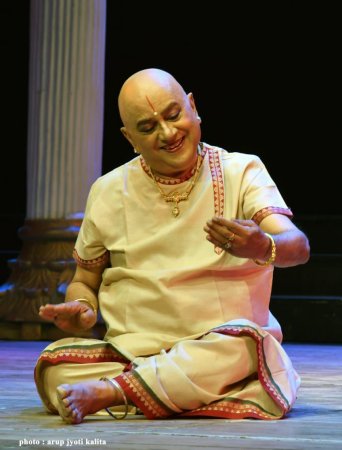 Deepak Mazumdar Guru and performer Deepak Mazumdar presented a composition from the Krishna Karnamrutham "Ramo nama babhuva, hum, tad-abala siteti, hum, tam piturvaca pancavati-vane viharatas tasyharad ravanah | nidrartham janaki-katham iti harer hum-karatah srnvatah, saumitre kva dhanur dhanur dhanur iti vyagra girah pantu nah||" delineating the story telling episode of mother Yashoda to little Krishna in the form of a lullaby, while the divine child kept saying 'hmm' for his mother to know that he is listening. And when she relates that Sita has been carried away by Ravana, little Krishna suddenly says aloud, "O Soumitri, where is my bow and arrow..." as though quickly slipping into his other avatara as Sri Rama. This is rarely performed as an individual piece and it was a delight to see the subtle choreography bringing it the nalinata of the mother in her efforts to make her divine child sleep long with the camouflaged expressions of the all-knowing Krishna. The body language and facial expressions displayed by Deepak Mazumdar reminded one of his guru Dr Kanak Rele's abhinaya. Years of training and guidance under her has made its mark on Deepak's performance style especially the aesthetics, sensitivity and subtlety in performance and aharya that has become rare to find. It was a master class for the young students who were present in large numbers. 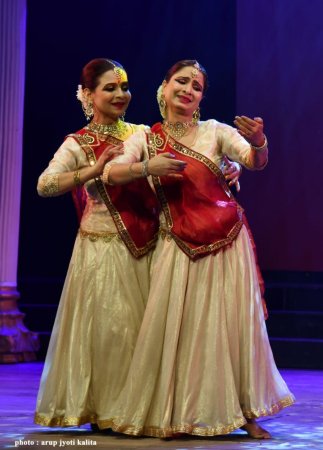 Ali Gunjan Kalita Mudiar and Chandrani Kalita Ojah The second short performance of Kathak by the duo Ali Gunjan Kalita Mudiar and Chandrani Kalita Ojah included an invocatory composition including the famous paran on Ganesh made extremely popular by the legendary tabla maestro Kishan Maharaj, especially the phrase "ativichitra Gana Nath aaj mridanga bajave". Credit goes to their Guru along with others who brought Kathak to Assam region. The duo also presented Teen Taal. 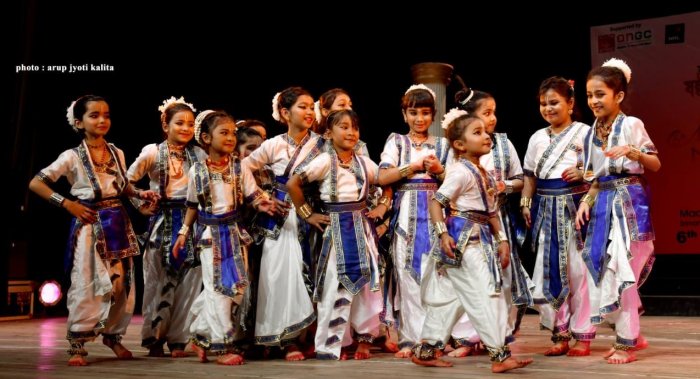 The junior most batch of students below 8 years of age Large groups of students at different levels presented a range of items translating the traditional aspects of the style with much zest and enthusiasm. It was cute to see the below 8 kids, the earnestness of the below 15 youngsters and the neat execution of the above 20 mid-level dancers. Amongst the presentations were Keertaniya sada hari, Mati Akhora with the basic grammar of sattriya, Jhumka and Geetor Naach using masculine postures and style in three parts - Ramdani, Geetor Naach and Mela Naach. Here the students performed only Ramdani and Geetor Naach, abhinaya on Borgeet and Bhatima; the abhinaya pieces were choreographed by Dipjyoti-Dipankar. 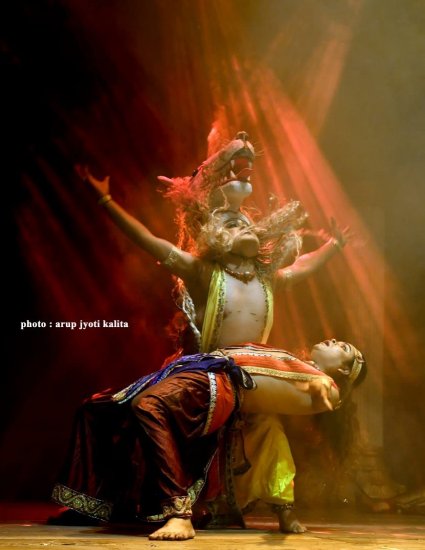 Narasimha The highlight of day one was the most captivating presentation of the Narasimha avatara, one of the incarnations of Maha Vishnu. The dance drama titled 'Narasimh' began with the description of how after years and years of rigorous meditation, Hiranyakashyapu was finally granted with the power of immortality by Lord Brahma. His much awaited desire, that no creature in the entire 3 worlds could kill him during the daytime as well as the night with any weapon was fulfilled too. The innovative entry of Brahma on the hamsa with five female dancers tiptoeing gracefully, almost lyrical movement was so pretty that it was noticed by every viewer. In fact, Guru Jatin Goswami made a special mention of how they have innovated the usual single person depiction on a hamsa to a five dancers approach here looking like a single unit. After receiving the boon, Hiranyakashyapu's uncontrollable irreverent behaviour, especially when he found his son Prahlad believing in the existence of Narayan, and his unquestionable devotion towards Lord Vishnu was not liked by his father. Hiranyakashyapu's hatred towards Lord Vishnu leads him to hate his own son. Prahlad's deep devotion towards Lord Vishnu compelled Hiranyakashyapu to plot conspiracies against little Prahlad. Hiranyakashyapu tried to punish Prahlad in the most brutal ways possible, but Prahlad's true devotion showed its colours. The irrevocable faith of Prahlad brought Lord Vishnu, the preserver of the 3 worlds, down to earth in his incarnated form of Narasimha - the half man and half lion. This piece was an extract from the Kirtan Ghosha by Srimanta Sankardev. Dipjyoti and Dipankar not only performed the lead roles, they also choreographed the dance drama. The students played different roles optimally. The music composition by Bhupen Nath and Kosha Mahanta was appropriate to the dramatic elements of the story. The instrumental interludes by Bishnu Sharma were extremely well entrenched within the presentation. What was immensely stunning was the ambiance lighting by designer Tapan Kumar Baruah. The second day (7 January) of the festival was inaugurated by eminent theatre director Dulal Roy, Dulal Manki, eminent Kathak exponent Marami Medhi, Sattriya Kendra project director Pratibha Sharma, Rajib Barua and Mahadananda Hazarika - Administrative officer. The early part of the evening was like the first day dedicated to the presentations of the students. The piece-de-resistance was 'Purushottam Ram' depicting the story of Rama in the Sattriya style. Dipankar and Dipjyoti must be commended on creating a magnum opus dance drama where they looked into every minute detail of the costumes, the props and stage design by Nuruddin Ahmed, the simple and complex choreography to suit as desired by the characters, the music and freshly composed lyrics, the mood lighting by Dimple Das and all this with no break. 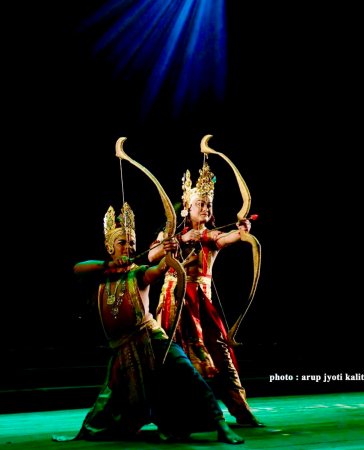 Rama & Lakshmana in Purushottam Ram 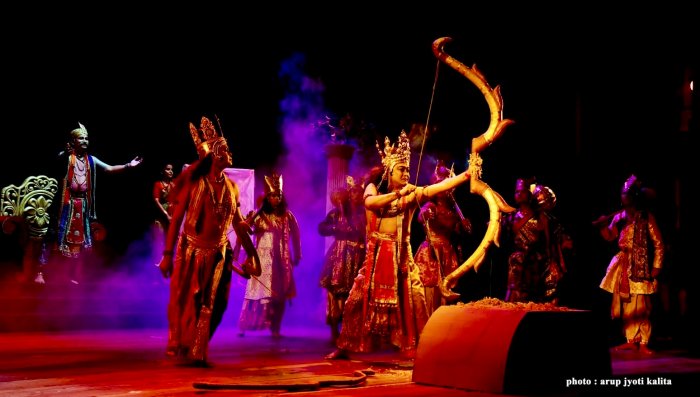 Sita Swayamvara in Purushottam Ram The choreography was interspersed with nritta portions that suited the character and its nature. For eg. Soorpanakha was played by two dancers, one as the aggressive asurapravrutti one and the other like a gentle enticing woman. The quick interchange was unbelievable. Similarly, the interchange between Ravana as the king and Ravana as the ascetic was also well executed. Some of these smart techniques enhanced the authenticity of the characters. This piece of work was mainly based on Madhav Kandali's Ramayan. Apart from this, some excerpts of Srimanta Sankardev's Ankiya Naat, Ram Vijay and Tulsi Das' Ramcharitmanas were also incorporated. Some of the episodes touched up on included the curse of the blind sire, birth of the four sons of Dasharath, Sita Swayamvara, the fall of the pride of Parashurama, the 14 years of exile of Rama, Jatayu Moksha, friendship with Sugreeva, Setu Bandhana and the death of Ravana. The script and music were by Bhaskarjyoti Ojha and the concept, direction and choreography were by the duo Dipankar and Dipjyoti, both Ustad Bismillah Khan Yuva Puraskar awardees. 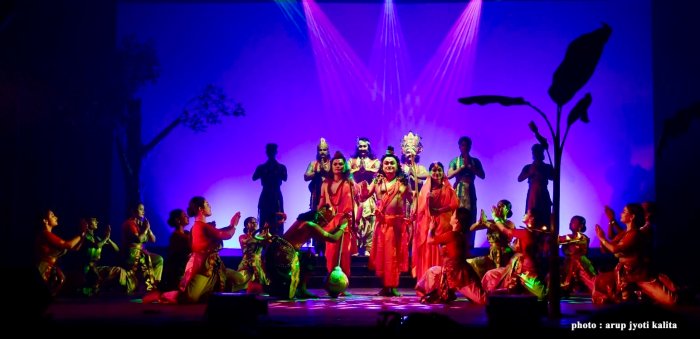 Rama Pattabhishekam in Purushottam Ram The lighting designers worked on a cinematic style of lighting. It is important to be informed that for the dance medium, lighting techniques are different from theatre or film. Lights must highlight the dancers so that their expressions are also clearly visible. Often one noticed that ambiance lighting and colour haze, specifically the smoke effects, could have been restricted. Manikanchan Kala Manjari also presented the Manikanchan Lifetime Achievement Award to Guru Jatin Goswami for his unparalleled contribution in bringing Sattriya to the national level. 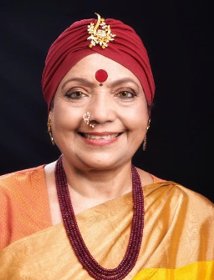 Dr. Usha Rk is an Arts Consultant and former Member Secretary, Ministry of Culture; former Director, Cultural Centre, Embassy of India in Moscow. Her conceptualisations of thematic dance presentations are appreciated and well received across India. |